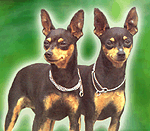Breed: Miniature Pinscher
Temperament: strong-willed, alert
Lifespan: 12-15 years
Maintenance: low
Recommended for: families, older adults
Looking like a pint-sized Dobermann with a fun-loving attitude, the Miniature Pinscher may be one of our most underrated small dogs. Mins Pins, as they are called, actually have a heritage which beats the Dobermann 200 years!
Appearance
A smooth-coated dog, weighing 3.5-4.5kg (8-10lb) and only reaching 30cm (12in.) is not a dwarf (ie: normal body on short legs) but as the name suggests, a miniature breed. They come in black, chocolate or blue with tan markings, or solid red. Their ears are large and erect. They are small enough to be nursed by children or older adults
Temperament & training
Like many small breeds, the Min Pin has self-confidence that outstrips its actual size and many make good watchdogs. Individuals can become overexcited and yappy if permitted, but most are alert and respond positively to training.
Dr. Rob Zammit says some Miniature Pinschers have temperament problems – they are shy, timid and can become fear biters. He suggests overcoming this by socialising the puppy early by introducing it to people and other dogs.
Health
Luxating patellas (slipping kneecap) and entropion (rolled-in eyelid) found occasionally; Fine leather of ears can crack and bleed in cold weather, or with fly bites in summer; Sensitive to cold.
Feeding
Dr. Rob Zammit warns potential owners against overfeeding Miniature Pinschers. If the dogs become fat their small bones can’t carry excess weight.
Breeding
Litters usually 3-4 pups, with caesareans required occasionally.
Space & exercise
Their small neat size makes them well suited to life indoors, however, the excitable nature sometimes found could demand extra training to avoid accidents with ornaments! While mostly self-exercising, a regular walk could burn off some of the excess energy.
Ideal owner
A great dog for families with school-age children, as breeders say they are hardier than they look and will join in the rough and tumble without danger of injury or retaliation. Older adults also find them a great companion, being small, cheap to feed, amenable to life indoors and a good watchdog.
Grooming
The short, sleek coat is simple to maintain with a weekly wipe over. Some owners warn against bathing too frequently as the skin can dry out and become irritated.
History
The breed originated in Germany where it was used to hunt rats and vermin. The word ‘pinsch’ is German for grab or snatch. Some still retain this instinct!
National contacts
To find up-to-date contacts for breeders, contact the following organisations.
Dogs NSW
http://www.dogsnsw.org.au/breeders-directory
Email: [email protected]
Phone: 1300 728 022 (NSW only) or (02) 9834 3022
Fax: (02) 9834 3872
Dogs Victoria
http://www.vca.org.au
Email: [email protected]
Phone: (03) 9788 2500
Fax: (03) 9788 2599
Dogs ACT
http://www.actca.asn.au
Email: [email protected]
Phone: (02) 6241 4404 – Fax: (02) 6241 1129.
Dogs West
http://www.cawa.asn.au
Email: [email protected]
Phone: (08) 9455 1188
Fax: (08) 9455 1190
Dogs SA
http://dogssa.com.au
Phone: (08) 8349 4797
Canine Control Council of Queensland
http://www.cccq.org.au
Email: [email protected]
Phone: (07) 3252 2661
Fax: (07) 3252 3864
Tasmanian Canine Association
http://www.tasdogs.com
Email: [email protected]
Phone: (03) 6272 9443
Fax: (03) 6273 0844
Dogs NT
http://www.territorydogworld.com
Email: [email protected]
Phone: (08) 8984 3570
Fax: (08) 8984 3409



